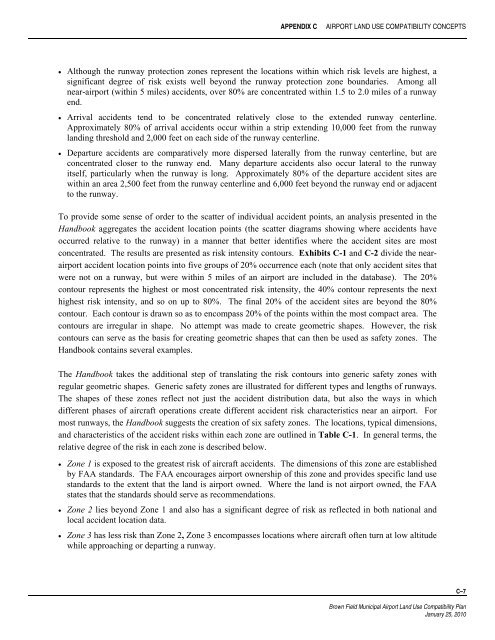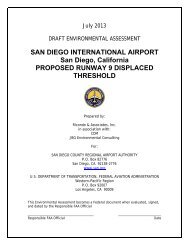Brown Field Municipal Airport Land Use Compatibility Plan
Brown Field Municipal Airport Land Use Compatibility Plan
Brown Field Municipal Airport Land Use Compatibility Plan
- No tags were found...
Create successful ePaper yourself
Turn your PDF publications into a flip-book with our unique Google optimized e-Paper software.
APPENDIX CAIRPORT LAND USE COMPATIBILITY CONCEPTS• Although the runway protection zones represent the locations within which risk levels are highest, asignificant degree of risk exists well beyond the runway protection zone boundaries. Among allnear-airport (within 5 miles) accidents, over 80% are concentrated within 1.5 to 2.0 miles of a runwayend.• Arrival accidents tend to be concentrated relatively close to the extended runway centerline.Approximately 80% of arrival accidents occur within a strip extending 10,000 feet from the runwaylanding threshold and 2,000 feet on each side of the runway centerline.• Departure accidents are comparatively more dispersed laterally from the runway centerline, but areconcentrated closer to the runway end. Many departure accidents also occur lateral to the runwayitself, particularly when the runway is long. Approximately 80% of the departure accident sites arewithin an area 2,500 feet from the runway centerline and 6,000 feet beyond the runway end or adjacentto the runway.To provide some sense of order to the scatter of individual accident points, an analysis presented in theHandbook aggregates the accident location points (the scatter diagrams showing where accidents haveoccurred relative to the runway) in a manner that better identifies where the accident sites are mostconcentrated. The results are presented as risk intensity contours. Exhibits C-1 and C-2 divide the nearairportaccident location points into five groups of 20% occurrence each (note that only accident sites thatwere not on a runway, but were within 5 miles of an airport are included in the database). The 20%contour represents the highest or most concentrated risk intensity, the 40% contour represents the nexthighest risk intensity, and so on up to 80%. The final 20% of the accident sites are beyond the 80%contour. Each contour is drawn so as to encompass 20% of the points within the most compact area. Thecontours are irregular in shape. No attempt was made to create geometric shapes. However, the riskcontours can serve as the basis for creating geometric shapes that can then be used as safety zones. TheHandbook contains several examples.The Handbook takes the additional step of translating the risk contours into generic safety zones withregular geometric shapes. Generic safety zones are illustrated for different types and lengths of runways.The shapes of these zones reflect not just the accident distribution data, but also the ways in whichdifferent phases of aircraft operations create different accident risk characteristics near an airport. Formost runways, the Handbook suggests the creation of six safety zones. The locations, typical dimensions,and characteristics of the accident risks within each zone are outlined in Table C-1. In general terms, therelative degree of the risk in each zone is described below.• Zone 1 is exposed to the greatest risk of aircraft accidents. The dimensions of this zone are establishedby FAA standards. The FAA encourages airport ownership of this zone and provides specific land usestandards to the extent that the land is airport owned. Where the land is not airport owned, the FAAstates that the standards should serve as recommendations.• Zone 2 lies beyond Zone 1 and also has a significant degree of risk as reflected in both national andlocal accident location data.• Zone 3 has less risk than Zone 2, Zone 3 encompasses locations where aircraft often turn at low altitudewhile approaching or departing a runway.C–7<strong>Brown</strong> <strong>Field</strong> <strong>Municipal</strong> <strong>Airport</strong> <strong>Land</strong> <strong>Use</strong> <strong>Compatibility</strong> <strong>Plan</strong>January 25, 2010
















